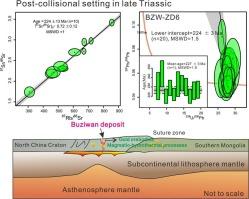华北克拉通补子湾角砾岩管晚三叠世金矿化:综合年代学揭示了岩浆热液系统与克拉通活化过程中的构造转变
IF 3.6
2区 地球科学
Q1 GEOLOGY
引用次数: 0
摘要
布子湾金矿床为角砾岩管型金矿床,已探明金储量超过10吨,是华北克拉通(NCC)内一种独特的成矿类型。尽管具有重要的经济意义,但热液矿化的确切时间仍然存在争议,提出的年龄范围从晚三叠纪到白垩纪。这种关键的不确定性阻碍了将成矿、角砾岩管演化和区域构造背景联系起来的确定成因模式的发展。为了解决这一地质年代学难题,我们提出了一项综合调查,结合野外地质调查、矿石显微技术和先进的原位地质年代学(绢云母Rb-Sr和单氮石U-Pb),并辅以Nd同位素系统。金矿主要以硫化物-石英-绢云母细脉在角砾岩管基质内赋存,空间上受东西向主断裂带约束。显微分析表明,金是硫化物中的天然颗粒,与绢云母、石英和独居石共生。独居石呈现弱Eu负异常(Eu/Eu* = 0.49 ~ 0.81)和低Th浓度(<0.38 wt%),证实其热液成因。单独居石高精度U-Pb定年得到的加权平均年龄分别为227±4 Ma和227±3 Ma,与角砾岩内隐伏二长斑岩的侵位年龄(229 Ma)和绢云母的Rb-Sr年龄(224±13 Ma)具有统计学上的一致性。这种强大的地质年代一致性建立了岩浆侵位、角砾岩管形成和晚三叠世金矿化之间的成因连续性。热液独居石的εNd(t)值与二长斑岩全岩样品的εNd(t)值相似,证实成矿流体是由长英质岩浆结晶析出的。这些流体沿着角砾岩管道网络迁移,通过裂缝充填沉淀硫化物。在构造上,这228-224 Ma成矿事件与古亚洲洋闭合后北陆岩石圈早期减薄和碰撞后的弛豫相吻合。本文认为,三叠纪前寒武纪微大陆边缘构造由挤压造山向伸展崩塌转变,以高热流和薄岩石圈为特征,对金矿化进行了动态调节。该模型不仅调和了含金角砾岩管道与同期火成岩套的时空联系,而且为克拉通活化带隐伏矿床提供了勘探载体。本文章由计算机程序翻译,如有差异,请以英文原文为准。

Late Triassic gold mineralization in the Buziwan breccia pipe (North China Craton): Integrated geochronology reveals magma-driven hydrothermal system and tectonic transition during cratonic reactivation
The Buziwan gold deposit, a breccia pipe-hosted deposit with proven reserves exceeding 10 tonnes Au, represents a distinct type of mineralization within the intracontinental North China Craton (NCC). Despite its economic significance, the precise timing of hydrothermal mineralization remains contentious, with proposed ages ranging from Late Triassic to Cretaceous. This critical uncertainty has hindered the development of definitive genetic models that link ore formation, breccia pipe evolution, and the regional tectonic setting. To resolve this geochronological dilemma, we present an integrated investigation combining field geological survey, ore microscopy, and advanced in-situ geochronology (sericite Rb-Sr and monazite U-Pb), complemented by Nd isotope systematics. Gold mineralization predominantly occurs as sulfide-quartz-sericite veinlets within the breccia pipe matrix, spatially constrained by an E-W striking main fault zone. Microscopic analysis reveals gold as native grains within sulfides, paragenetically associated with sericite, quartz, and monazite. Monazite exhibits weak negative Eu anomalies (Eu/Eu* = 0.49–0.81) and low Th concentrations (<0.38 wt%), confirming its hydrothermal genesis. High-precision U-Pb dating of monazite yields weighted mean ages of 227 ± 4 Ma and 227 ± 3 Ma, statistically consistent with the emplacement age of a concealed monzonite porphyry (229 Ma) within the breccia complex and the sericite Rb-Sr age (224 ± 13 Ma). This robust geochronological congruence establishes a genetic continuum between magma emplacement, breccia pipe formation, and gold mineralization during the Late Triassic. Hydrothermal monazite εNd(t) values are similar to those of the monzonite porphyry whole-rock samples, confirming ore-forming fluids exsolved from the crystallizing felsic magmas. These fluids migrated along breccia-conduit networks, precipitating sulfides via fracture-filling. Tectonically, this 228–224 Ma metallogenic event coincides with incipient lithospheric thinning and post-collisional relaxation of the NCC following the closure of the Paleo-Asian Ocean. We propose that gold mineralization was dynamically modulated by the Triassic tectonic transition from compressional orogeny to extensional collapse along Precambrian microcontinental margins – a regime characterized by high heat flow and a thinned lithosphere. This model not only reconciles the spatiotemporal association between auriferous breccia pipes and coeval igneous suites but also provides exploration vectors for concealed deposits in cratonic reactivation zones.
求助全文
通过发布文献求助,成功后即可免费获取论文全文。
去求助
来源期刊

Ore Geology Reviews
地学-地质学
CiteScore
6.50
自引率
27.30%
发文量
546
审稿时长
22.9 weeks
期刊介绍:
Ore Geology Reviews aims to familiarize all earth scientists with recent advances in a number of interconnected disciplines related to the study of, and search for, ore deposits. The reviews range from brief to longer contributions, but the journal preferentially publishes manuscripts that fill the niche between the commonly shorter journal articles and the comprehensive book coverages, and thus has a special appeal to many authors and readers.
 求助内容:
求助内容: 应助结果提醒方式:
应助结果提醒方式:


